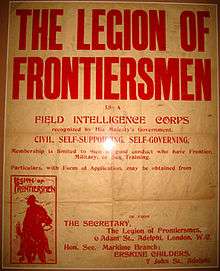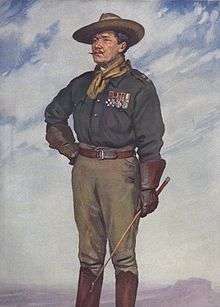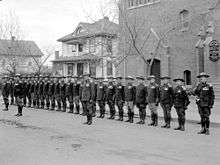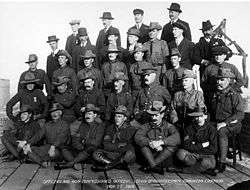Legion of Frontiersmen
| Legion of Frontiersmen | |
|---|---|
|
Legion of Frontiersmen, Edmonton, Alberta, 1915. | |
| Active | 1905- |
| Country |
|
| Role | Patriotic |
| Part of | Paramilitary group |
| Motto(s) | God Guard Thee |
| Commanders | |
| Patron | Countess Mountbatten of Burma.[1] |

The Legion of Frontiersmen is a paramilitary group formed in Britain in 1905 by Roger Pocock, a former constable with the North-West Mounted Police and Boer War veteran.
Prompted by fears of an impending invasion of Britain and the Empire, the organisation was founded as a field intelligence corps on a romanticised conception of the "frontier" and imperial idealism. Headquartered in London, branches of the Legion of Frontiersmen were formed throughout the empire to prepare patriots for war and to foster vigilance in peacetime. Despite persistent efforts, the Legion never achieved much official recognition.
Casualties in the First World War devastated the Legion of Frontiersmen, and except for a brief resurgence in the interwar period, a series of schisms and sectarianism prevented attempts to reinvigorate the movement. In the late 1930s, the Legion of Frontiersmen in Canada was formally affiliated with the Royal Canadian Mounted Police, but after a schism split within the Canadian Frontiersmen, the RCMP severed formal ties.[2] Various Legion of Frontiersmen groups still exist throughout the Commonwealth, but as a whole, it has been unable to define its niche in the post-imperial world.
First world war

During the First World War, the Legion of Frontiersmen helped raise and fill the ranks of the Princess Patricia's Canadian Light Infantry, the 19th Alberta Dragoons, the 49th Battalion - Canadian Expeditionary Force (today's Loyal Edmonton Regiment), the 210th Battalion (Frontiersmen), - Canadian Expeditionary Force,[3][4] the 25th (Frontiersmen) Battalion, Royal Fusiliers,[5] and the Newfoundland Regiment.[6]
Uniforms

The earliest official description of an authorized uniform for a Canadian unit is noted in The Frontiersman, (December 1912, page 223) describing Vernon and Okanagan Command’s uniform as follows: “Shirt Tunic – To be of substantial material, colour navy blue; leather buttons; nickel shoulder chains. Breeches or (Trousers) – Any shade of khaki. Footwear – Brown leather; any combination that affords cover as high as the calves. Headdress – Straight brim Stetson, any shade of brown, with leather band and regimental crest and monogram. Accessories – Brown leather fringed gauntlets; silk blue and white “bird’s-eye” neckerchief; regulation LF holster.”[7]
The Current dress uniform is generally centred around a cavalry blues theme - complete with shoulder chains. This is either worn with a russett-coloured beret, an SD cap or a colonial-pattern 'Lemon Squeezer' (Smokey Bear hat). Jodhpurs and riding boots are worn by the 'Legion of Horse' when 'mounted'.
Decorations
Different branches of the legion, in different parts of the Commonwealth award medals within their units and occasionally to external branches, commands or units.[8] These medals are not part of any government honours system and should not be treated or claimed as any kind of official military decoration. These medals are much like those of the Freemasons,[9] valued only by members. The Australian Division awards a decoration called the "Australian Medal of Merit" (internally used post nominal letters AMM)[10] that has caused controversy where it has been implied by an occasional recipient that it is a government-endorsed, official medal.[11]
Sources
- Christopher M. Andrew, Secret Service: The Making of the British Intelligence Community. London: Trafalgar Square, 1985. ISBN 978-0-340-40430-0
- Robert H. MacDonald, Sons of the Empire: The Frontier and the Boy Scout Movement, 1890–1918. Toronto: University of Toronto Press, 1993. ISBN 978-0-8020-2843-3
- John Fisher. Gentleman Spies: intelligence agents in the British Empire and beyond. Stroud, UK: Sutton, 2002. ISBN 0-7509-2698-8
- Geoffrey A. Pocock. One Hundred Years of the Legion of Frontiersmen. Chichester, UK: Phillimore, 2004. ISBN 978-1-86077-282-5
References
- ↑ "Frontiersmen After the Second War". Frontiersmenhistorian.info. Retrieved 2014-06-27.
- ↑ Dave Mason, University of Toronto Rare Books. Retrieved 4 March 2007; B. W. Shandro, “The Legion of Frontiersmen of the Commonwealth Canada," Retrieved 4 March 2007.
- ↑ "Canadian Military History Gateway - Glossary". Cmhg.gc.ca. 2011-11-03. Retrieved 2014-06-27.
- ↑ "The Saskatchewan Dragoons". Saskd.ca. Retrieved 2014-06-27.
- ↑ "The Royal Fusiliers in 1914-1918". 1914-1918.net. Retrieved 2014-06-27.
- ↑ "Paramilitary Groups". Heritage.nf.ca. Retrieved 2014-06-27.
- ↑ "Legion of Frontiersmen - Boer War Veteran". Soldiers of the Queen. Retrieved 2014-06-27.
- ↑ "Ribbon Chart" (PDF). Retrieved 2014-06-27.
- ↑ [Trevor I. Harris(2006) ISBN 978-0-9554447-0-8 ISBN 0955444705]
- ↑
- ↑ Australian and New Zealand Military Imposters Archived April 16, 2009, at the Wayback Machine.
External links
- History of the Frontiersmen
- Australian Division
- New Zealand Command
- NZ Command Pro Patria
- Scottish Command 1st Highland Brigade LOF Vols (Yeomanry)
- Welsh Auxiliary Corps of Frontiersmen
- Countess Mountbatten's Own
- 3e Régiment de Lanciers
- Canadian Corps of Frontiersmen
